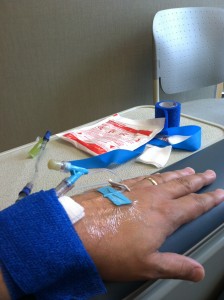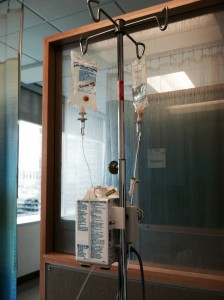What to Expect When Getting an Infusion Medicine for RA
Needles and RA go hand-in-hand. When patients are prescribed injectable methotrexate or one of the first line biologic medicines like Enbrel or Humira, they tend to stress over the fact that needles are becoming part of their healthcare regimen.
These medicines are usually self-injected at home. While it takes a little gumption to poke yourself, it can be done relatively quickly.
IV infusions vs. self-injectables
There are, however, several RA medications that are required to be administered via intravenous (IV) infusion at a clinic under the supervision of a nurse. The reasons that these drugs must be administered via infusion include the facts that the volume of medicine is beyond what can be packaged in a portable syringe and potential side effects of the drugs.
The four RA drugs that are infusion-based are:
- Remicade
- Orencia
- Actemra
- Rituximab (Rituxan)
Remicade takes about 3-4 hours per infusion, Orencia and Actemra takes about an hour, and Rituxan takes 5-6 hours for the total process.
My experience
Personally, I’ve been on all four of these medicines and it’s old hat for me to go into the clinic for an infusion. I know the process, what to expect, and the nurses even know me by name. But when a patient is a “newbie” to the process, it can be a little intimidating. I thought it might be helpful to provide a personal description of the process – sort of a play by play.
RA infusion centers compared to doctor's offices
My infusion clinic is near the oncology offices because many cancer patients are receiving chemotherapy via infusion. It feels a little strange walking into such a place as many of the patients around you are in serious and life threatening situations. But then that reminds me the serious nature of rheumatoid arthritis.
The clinic contains small and private cubicles for each patient. Unlike other doctor offices, you just walk in and immediately meet a nurse who escorts you to a cubicle that contains a lounge chair, TV, guest chair, infusion pump machine, and a drawer full of equipment and supplies.
Preparing for your RA infusion
Once settled in the chair, the nurse takes blood pressure measurements and then an infusion needle is inserted into a vein. I’ve had infusions in my elbow, arm and hand depending on which vein seems to be popping out the best. Staying hydrated before the infusion helps keep the veins ready. Sometimes vials of blood are drawn to run typical RA blood tests like complete blood count (CBC), sedimentation rates, and liver panels.
The medicine is contained in a solution and is infused, not dripped, meaning that a pump provides the force pushing it into your body. The pump makes a whirring sound every few seconds.
Stay occupied
For infusions lasting several hours, it is good to bring something to keep yourself occupied such as music, videos, books, and food. I get up periodically to stretch and go to the restroom when needed. The entire IV and pump set up is mobile and can be wheeled around if needed. The pump is battery operated but must be plugged in when not moving so the battery can remain fully charged.
What to expect during the infusion
The nurse periodically comes by to check on how I’m feeling. When the medicine bag is empty, a beeper on the infusion pump sounds and the nurse comes to shut everything down and to remove the IV. Towards the end I find myself constantly checking the bag to see how close it is to being empty!
Some saline solution may be pushed through the drip line to flush all of the expensive medicine into your body. When this happens I feel a cold sensation in my arm. Finally, a pressure bandage is wrapped to keep the site from bleeding and they suggest leaving it on for 15-30 minutes.
Infusions can take a long time
I’m currently on Rituxan and the infusion clinic likes to schedule these infusions early in the day since the entire process can take up to 6 hours. Rituxan requires a set of pre-medications that are designed to squelch possible infusion reactions.
The pre-meds include Tylenol, Solu-medrol, and Benadryl. The Solu-medrol, a corticosteroid, is injected directly into the IV but the nurse does it slowly in order to avoid a “head rush” as she calls it. The 100mg dose seems massive compared to the 4mg pills that I take periodically. This amount tends to keep me awake far into the next morning and makes me constantly hungry for the next 24 hours.
The Benadryl is an anti-histamine and is infused from a bag. Some clinics will allow patients to take oral Benadryl before coming in. One side effect of the Benadryl for me is that it makes me rather loopy and groggy and I usually sleep for about an hour. During my first Rituxan infusion, I also had 500mg of saline solution infused to make sure I was hydrated. They did not do this on the second infusion.
The entire infusion process is usually pretty uneventful and side effects from the infused drugs are possible but not very common. I've found that the infusion clinic nurses are the best and most professional in the health care world and they are amazing at making the process as comfortable as possible.
Below are some pictures of one of my infusions.


Join the conversation